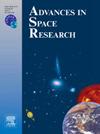On the application of reflectivity control devices in spacecraft attitude control
IF 2.8
3区 地球科学
Q2 ASTRONOMY & ASTROPHYSICS
引用次数: 0
Abstract
This paper investigates the application of reflectivity control devices in spacecraft attitude control. In reflectivity control devices, in particular, the polymer-dispersed liquid–crystal type, the light transmission properties of the film can be altered from transparent to opaque by adjusting the amount of applied voltage. This technology has previously been applied to residential and commercial buildings and, recently, it has been widely adopted in the automotive industry for purposes such as electrochromic glass roofs. Since spacecraft in orbit receive a continuous flow of photons emitted from the Sun (when in the sunlit portion of their orbits), the momentum transferred from these photons to the spacecraft can be utilized for attitude and orbit control. The focus of this paper is on attitude control through strategically adjusting the transparency of reflectivity-control panels attached to the spacecraft away from its center of mass. In this paper, a conceptual design for a spacecraft equipped with reflectivity-control device panels is presented, and the equations of attitude motion coupled with control torques produced by these devices are derived. Furthermore, a control strategy for detumbling a small satellite, such as a CubeSat, is investigated. To assess the viability of reflectivity-control technology in spacecraft attitude control, a number of case studies are presented. The performance of these devices is discussed in light of the results obtained from the numerical simulations.
求助全文
约1分钟内获得全文
求助全文
来源期刊

Advances in Space Research
地学天文-地球科学综合
CiteScore
5.20
自引率
11.50%
发文量
800
审稿时长
5.8 months
期刊介绍:
The COSPAR publication Advances in Space Research (ASR) is an open journal covering all areas of space research including: space studies of the Earth''s surface, meteorology, climate, the Earth-Moon system, planets and small bodies of the solar system, upper atmospheres, ionospheres and magnetospheres of the Earth and planets including reference atmospheres, space plasmas in the solar system, astrophysics from space, materials sciences in space, fundamental physics in space, space debris, space weather, Earth observations of space phenomena, etc.
NB: Please note that manuscripts related to life sciences as related to space are no more accepted for submission to Advances in Space Research. Such manuscripts should now be submitted to the new COSPAR Journal Life Sciences in Space Research (LSSR).
All submissions are reviewed by two scientists in the field. COSPAR is an interdisciplinary scientific organization concerned with the progress of space research on an international scale. Operating under the rules of ICSU, COSPAR ignores political considerations and considers all questions solely from the scientific viewpoint.
 求助内容:
求助内容: 应助结果提醒方式:
应助结果提醒方式:


